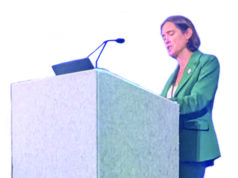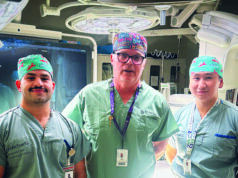
A Vascular Quality Initiative (VQI) analysis of evolving practice in the wake of the BEST-CLI trial demonstrated no increase in the rate of surgical bypass in the year afterwards.
More analysis needs to be done comparing the data pre- and post-publication of BEST-CLI in the New England Journal of Medicine (NEJM) in November 2022, explains lead author Marc Schermerhorn, MD, “but I still think it’s surprising that there has been essentially no increase whatsoever about a year later. There wasn’t really a trend.”
Among 29,000 patients, overall use of bypass was 15%, the chief of vascular surgery at Beth Israel Deaconess Medical Center in Boston continues. “When we compared the time period before the publication and the time period afterwards, it really didn’t change: it went from 14% to 15%; in men it went from 16% to 14%; and women from 11% to 16%—but none of those are anything close to anything significant.”
Broken down by segment, there was still no change, Schermerhorn added of the data, which will be presented at the New England Society for Vascular Surgery (NESVS) annual meeting in Portland, Maine (Oct. 25–27).
BEST-CLI demonstrated that surgical bypass with adequate single-segment great saphenous vein (GSV) is a more effective revascularization strategy for patients with chronic limb-threatening ischemia (CLTI) who are deemed to be suitable for either an open or endovascular approach.
Speaking with Vascular Specialist ahead of the NESVS meeting, Schermerhorn points to several possibilities to explain why the needle hasn’t shifted.
“It always takes time after new data comes out for it to diffuse out broadly,” he says. “I suspect that that’s the main thing. Sometimes practice doesn’t change until a guideline comes out.” As chair of the Society for Vascular Surgery (SVS) Document Oversight Committee, he points out an update of the CLTI guidelines is in the works. “That will certainly incorporate [the BEST-CLI trail data],” Schermerhorn adds, explaining that that too remains more than a year down the road owing to the guideline development process. “We will re-evaluate this after that to see if there is a change after the guidelines are published … I think we need to get the word out to more people, to the New England community, to the SVS and internationally—that people with a good single-segment saphenous vein should at least be considered for bypass more so that they were in the past.”
Schermerhorn acknowledges that there may be differing interpretations of the BEST-CLI results between specialties to a certain extent but says even among vascular surgeons there may be a hesitancy to do more bypasses. “People have gotten so used to doing peripheral interventions, and their volume of bypass grafts have gone way down,” he explains. “It’s possible that surgeons are less comfortable with bypass than they used to be, or that they’re more fearful of the potential complications and feel that the patients are too frail for bypass. And that may well be the case for many patients.”
The Harvard University professor of surgery also concedes that the BASIL-2 trial results, though based on a slightly different patient population, may be “holding things back.” As a result, he believes those data should likewise be “considered differently” and underscores his belief that bypasses should nevertheless be performed more often. “[BEST-CLI] certainly changed my practice and that of our group,” says Schermerhorn. “We always check to see if someone has got saphenous vein before we do an angio, which is something we started doing when we participated in the trial. We hadn’t done that previously. We’re much more likely now in a patient with extensive multi-level disease—and significant ischemia and significant foot lesions—to recommend bypass.”
He finishes by referencing an analysis conducted by a partner that looked at graduating vascular surgery trainees’ facility with infrapopliteal bypasses. “It showed that when they graduate, they have done very, very few during their training period—I think the average is well below 10,” Schermerhorn says. “The last time we looked at that was probably eight or 10 years ago. It’s an area where people are not being trained adequately because we have made such a switch to peripheral intervention.”












